Implementing Smart Buildings Based on Internet of Things Project
VerifiedAdded on 2022/12/29
|10
|2261
|94
Project
AI Summary
This project proposal focuses on the implementation of smart buildings based on the Internet of Things (IoT). The proposal begins with background information on the evolution of smart buildings and the role of IoT in enhancing building operations, reducing costs, and improving user well-being. It highlights the issues in traditional buildings, the benefits of IoT integration, and the use of building automation systems. The objectives are to identify issues in traditional buildings, analyze the implementation of IoT in smart buildings, and recommend strategies for improvement. The methodology involves a qualitative approach, utilizing literature reviews and secondary data analysis to address research questions about issues in traditional buildings, IoT implementation, and improvement strategies. The expected outcomes include a clear image of the benefits of smart buildings, a comparison of traditional and smart buildings, and solutions provided by IoT. The proposal includes a program of work, resource requirements, and references, providing a comprehensive plan for the project.
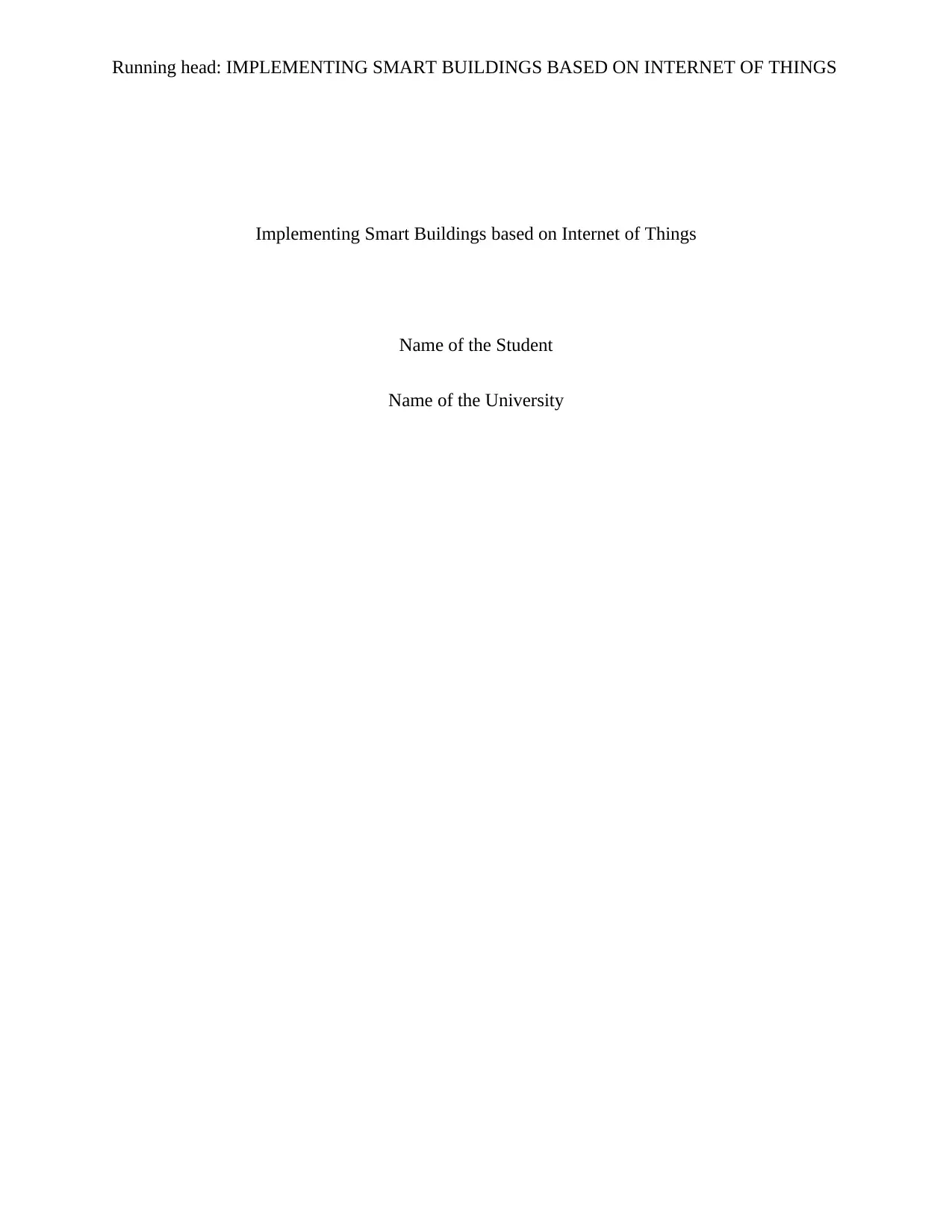
Running head: IMPLEMENTING SMART BUILDINGS BASED ON INTERNET OF THINGS
Implementing Smart Buildings based on Internet of Things
Name of the Student
Name of the University
Implementing Smart Buildings based on Internet of Things
Name of the Student
Name of the University
Paraphrase This Document
Need a fresh take? Get an instant paraphrase of this document with our AI Paraphraser
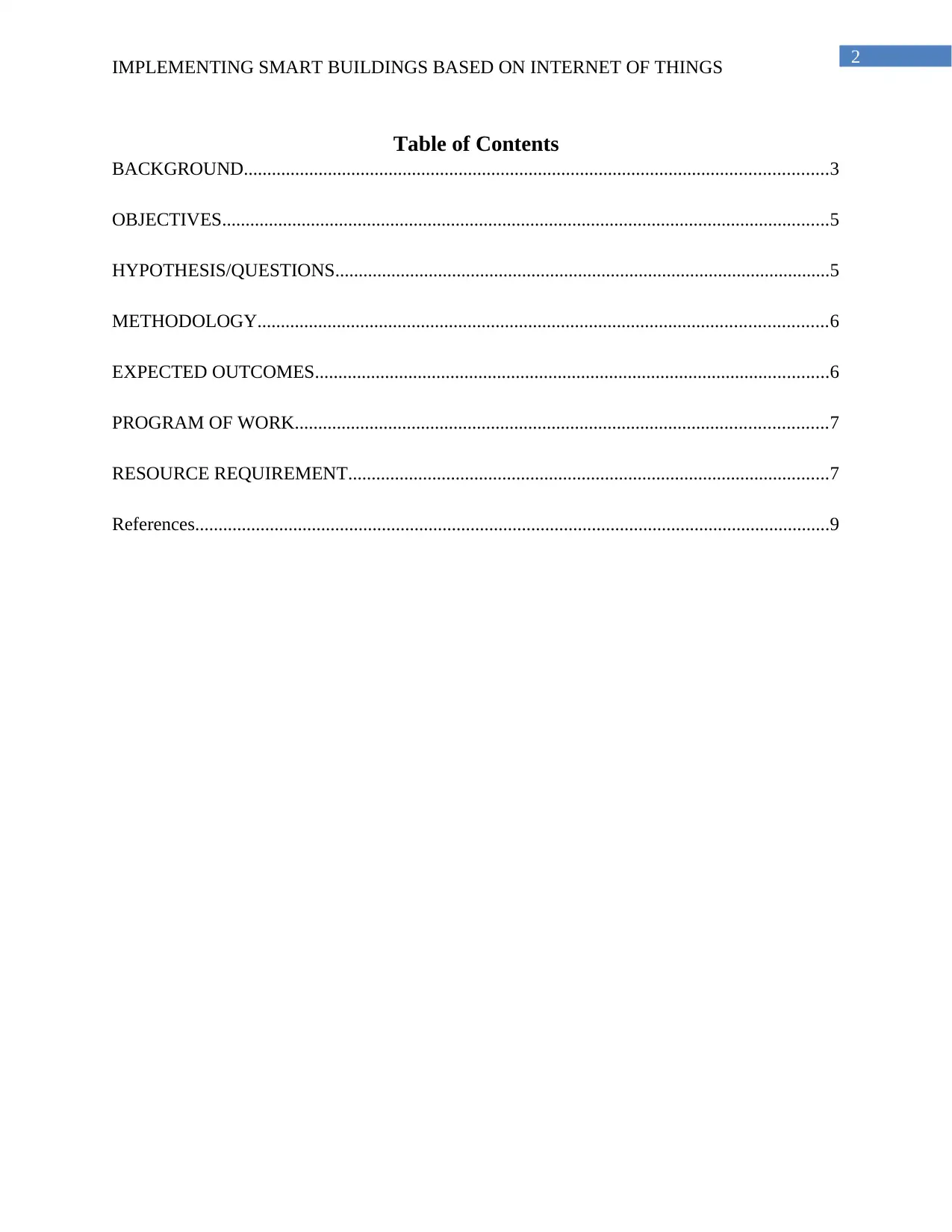
2
IMPLEMENTING SMART BUILDINGS BASED ON INTERNET OF THINGS
Table of Contents
BACKGROUND.............................................................................................................................3
OBJECTIVES..................................................................................................................................5
HYPOTHESIS/QUESTIONS..........................................................................................................5
METHODOLOGY..........................................................................................................................6
EXPECTED OUTCOMES..............................................................................................................6
PROGRAM OF WORK..................................................................................................................7
RESOURCE REQUIREMENT.......................................................................................................7
References........................................................................................................................................9
IMPLEMENTING SMART BUILDINGS BASED ON INTERNET OF THINGS
Table of Contents
BACKGROUND.............................................................................................................................3
OBJECTIVES..................................................................................................................................5
HYPOTHESIS/QUESTIONS..........................................................................................................5
METHODOLOGY..........................................................................................................................6
EXPECTED OUTCOMES..............................................................................................................6
PROGRAM OF WORK..................................................................................................................7
RESOURCE REQUIREMENT.......................................................................................................7
References........................................................................................................................................9
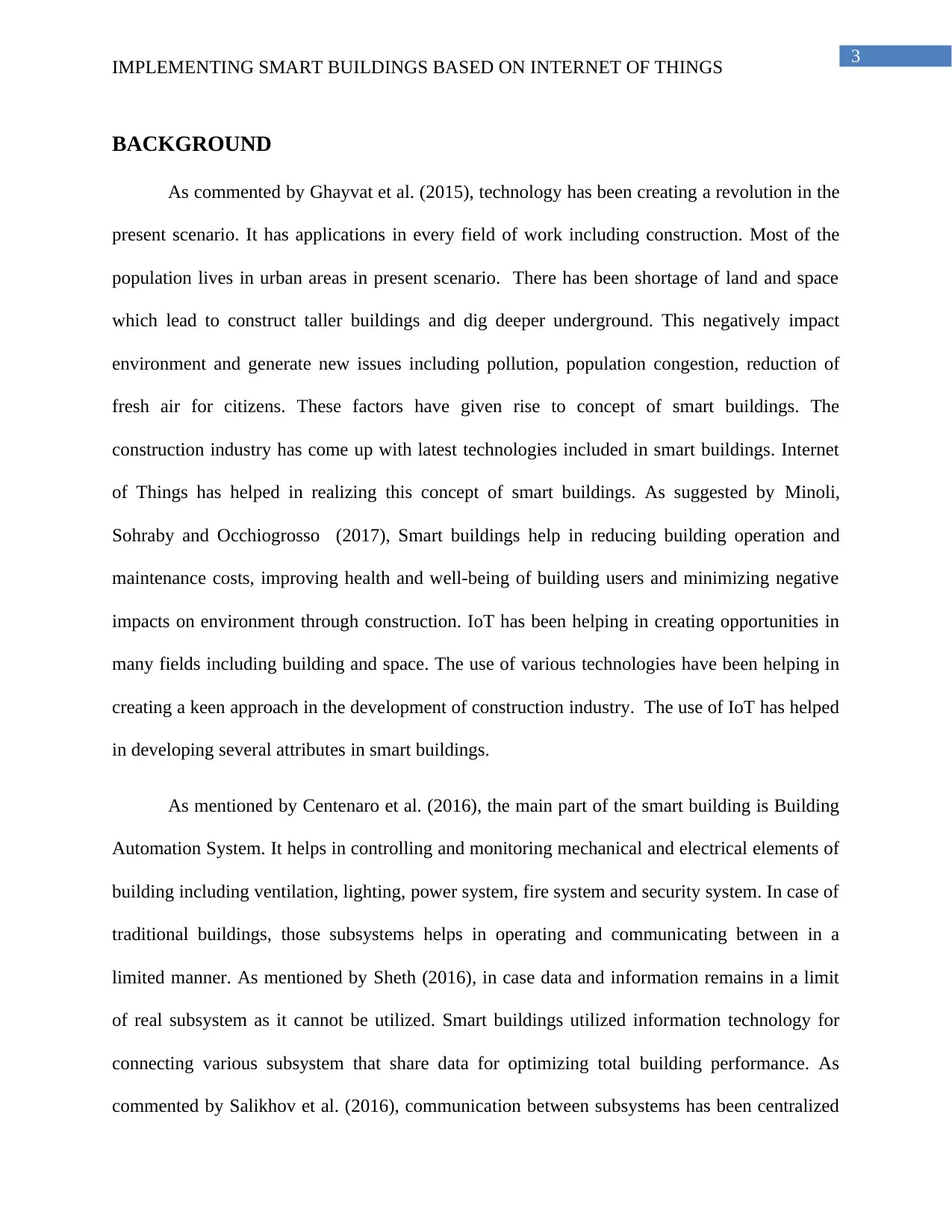
3
IMPLEMENTING SMART BUILDINGS BASED ON INTERNET OF THINGS
BACKGROUND
As commented by Ghayvat et al. (2015), technology has been creating a revolution in the
present scenario. It has applications in every field of work including construction. Most of the
population lives in urban areas in present scenario. There has been shortage of land and space
which lead to construct taller buildings and dig deeper underground. This negatively impact
environment and generate new issues including pollution, population congestion, reduction of
fresh air for citizens. These factors have given rise to concept of smart buildings. The
construction industry has come up with latest technologies included in smart buildings. Internet
of Things has helped in realizing this concept of smart buildings. As suggested by Minoli,
Sohraby and Occhiogrosso (2017), Smart buildings help in reducing building operation and
maintenance costs, improving health and well-being of building users and minimizing negative
impacts on environment through construction. IoT has been helping in creating opportunities in
many fields including building and space. The use of various technologies have been helping in
creating a keen approach in the development of construction industry. The use of IoT has helped
in developing several attributes in smart buildings.
As mentioned by Centenaro et al. (2016), the main part of the smart building is Building
Automation System. It helps in controlling and monitoring mechanical and electrical elements of
building including ventilation, lighting, power system, fire system and security system. In case of
traditional buildings, those subsystems helps in operating and communicating between in a
limited manner. As mentioned by Sheth (2016), in case data and information remains in a limit
of real subsystem as it cannot be utilized. Smart buildings utilized information technology for
connecting various subsystem that share data for optimizing total building performance. As
commented by Salikhov et al. (2016), communication between subsystems has been centralized
IMPLEMENTING SMART BUILDINGS BASED ON INTERNET OF THINGS
BACKGROUND
As commented by Ghayvat et al. (2015), technology has been creating a revolution in the
present scenario. It has applications in every field of work including construction. Most of the
population lives in urban areas in present scenario. There has been shortage of land and space
which lead to construct taller buildings and dig deeper underground. This negatively impact
environment and generate new issues including pollution, population congestion, reduction of
fresh air for citizens. These factors have given rise to concept of smart buildings. The
construction industry has come up with latest technologies included in smart buildings. Internet
of Things has helped in realizing this concept of smart buildings. As suggested by Minoli,
Sohraby and Occhiogrosso (2017), Smart buildings help in reducing building operation and
maintenance costs, improving health and well-being of building users and minimizing negative
impacts on environment through construction. IoT has been helping in creating opportunities in
many fields including building and space. The use of various technologies have been helping in
creating a keen approach in the development of construction industry. The use of IoT has helped
in developing several attributes in smart buildings.
As mentioned by Centenaro et al. (2016), the main part of the smart building is Building
Automation System. It helps in controlling and monitoring mechanical and electrical elements of
building including ventilation, lighting, power system, fire system and security system. In case of
traditional buildings, those subsystems helps in operating and communicating between in a
limited manner. As mentioned by Sheth (2016), in case data and information remains in a limit
of real subsystem as it cannot be utilized. Smart buildings utilized information technology for
connecting various subsystem that share data for optimizing total building performance. As
commented by Salikhov et al. (2016), communication between subsystems has been centralized
⊘ This is a preview!⊘
Do you want full access?
Subscribe today to unlock all pages.

Trusted by 1+ million students worldwide
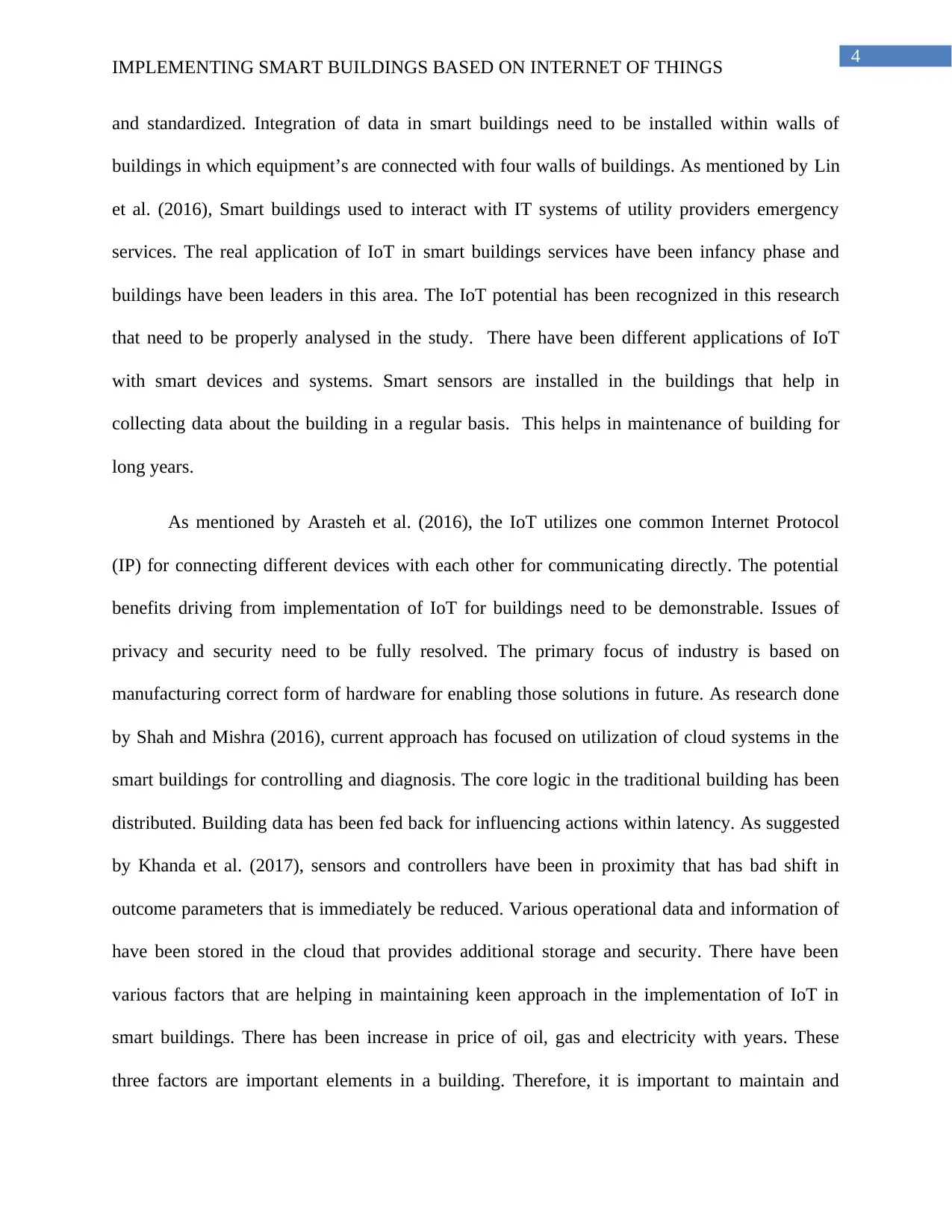
4
IMPLEMENTING SMART BUILDINGS BASED ON INTERNET OF THINGS
and standardized. Integration of data in smart buildings need to be installed within walls of
buildings in which equipment’s are connected with four walls of buildings. As mentioned by Lin
et al. (2016), Smart buildings used to interact with IT systems of utility providers emergency
services. The real application of IoT in smart buildings services have been infancy phase and
buildings have been leaders in this area. The IoT potential has been recognized in this research
that need to be properly analysed in the study. There have been different applications of IoT
with smart devices and systems. Smart sensors are installed in the buildings that help in
collecting data about the building in a regular basis. This helps in maintenance of building for
long years.
As mentioned by Arasteh et al. (2016), the IoT utilizes one common Internet Protocol
(IP) for connecting different devices with each other for communicating directly. The potential
benefits driving from implementation of IoT for buildings need to be demonstrable. Issues of
privacy and security need to be fully resolved. The primary focus of industry is based on
manufacturing correct form of hardware for enabling those solutions in future. As research done
by Shah and Mishra (2016), current approach has focused on utilization of cloud systems in the
smart buildings for controlling and diagnosis. The core logic in the traditional building has been
distributed. Building data has been fed back for influencing actions within latency. As suggested
by Khanda et al. (2017), sensors and controllers have been in proximity that has bad shift in
outcome parameters that is immediately be reduced. Various operational data and information of
have been stored in the cloud that provides additional storage and security. There have been
various factors that are helping in maintaining keen approach in the implementation of IoT in
smart buildings. There has been increase in price of oil, gas and electricity with years. These
three factors are important elements in a building. Therefore, it is important to maintain and
IMPLEMENTING SMART BUILDINGS BASED ON INTERNET OF THINGS
and standardized. Integration of data in smart buildings need to be installed within walls of
buildings in which equipment’s are connected with four walls of buildings. As mentioned by Lin
et al. (2016), Smart buildings used to interact with IT systems of utility providers emergency
services. The real application of IoT in smart buildings services have been infancy phase and
buildings have been leaders in this area. The IoT potential has been recognized in this research
that need to be properly analysed in the study. There have been different applications of IoT
with smart devices and systems. Smart sensors are installed in the buildings that help in
collecting data about the building in a regular basis. This helps in maintenance of building for
long years.
As mentioned by Arasteh et al. (2016), the IoT utilizes one common Internet Protocol
(IP) for connecting different devices with each other for communicating directly. The potential
benefits driving from implementation of IoT for buildings need to be demonstrable. Issues of
privacy and security need to be fully resolved. The primary focus of industry is based on
manufacturing correct form of hardware for enabling those solutions in future. As research done
by Shah and Mishra (2016), current approach has focused on utilization of cloud systems in the
smart buildings for controlling and diagnosis. The core logic in the traditional building has been
distributed. Building data has been fed back for influencing actions within latency. As suggested
by Khanda et al. (2017), sensors and controllers have been in proximity that has bad shift in
outcome parameters that is immediately be reduced. Various operational data and information of
have been stored in the cloud that provides additional storage and security. There have been
various factors that are helping in maintaining keen approach in the implementation of IoT in
smart buildings. There has been increase in price of oil, gas and electricity with years. These
three factors are important elements in a building. Therefore, it is important to maintain and
Paraphrase This Document
Need a fresh take? Get an instant paraphrase of this document with our AI Paraphraser
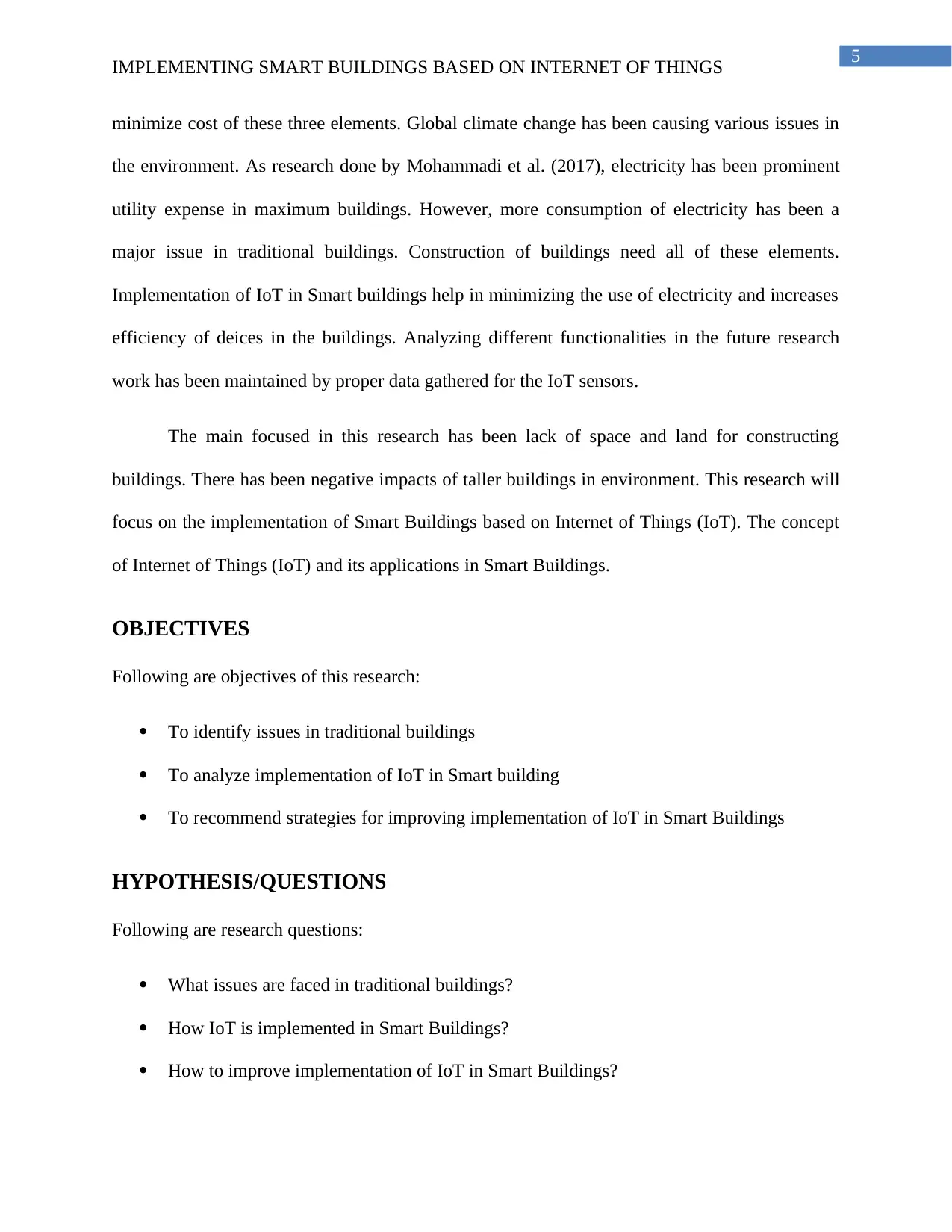
5
IMPLEMENTING SMART BUILDINGS BASED ON INTERNET OF THINGS
minimize cost of these three elements. Global climate change has been causing various issues in
the environment. As research done by Mohammadi et al. (2017), electricity has been prominent
utility expense in maximum buildings. However, more consumption of electricity has been a
major issue in traditional buildings. Construction of buildings need all of these elements.
Implementation of IoT in Smart buildings help in minimizing the use of electricity and increases
efficiency of deices in the buildings. Analyzing different functionalities in the future research
work has been maintained by proper data gathered for the IoT sensors.
The main focused in this research has been lack of space and land for constructing
buildings. There has been negative impacts of taller buildings in environment. This research will
focus on the implementation of Smart Buildings based on Internet of Things (IoT). The concept
of Internet of Things (IoT) and its applications in Smart Buildings.
OBJECTIVES
Following are objectives of this research:
To identify issues in traditional buildings
To analyze implementation of IoT in Smart building
To recommend strategies for improving implementation of IoT in Smart Buildings
HYPOTHESIS/QUESTIONS
Following are research questions:
What issues are faced in traditional buildings?
How IoT is implemented in Smart Buildings?
How to improve implementation of IoT in Smart Buildings?
IMPLEMENTING SMART BUILDINGS BASED ON INTERNET OF THINGS
minimize cost of these three elements. Global climate change has been causing various issues in
the environment. As research done by Mohammadi et al. (2017), electricity has been prominent
utility expense in maximum buildings. However, more consumption of electricity has been a
major issue in traditional buildings. Construction of buildings need all of these elements.
Implementation of IoT in Smart buildings help in minimizing the use of electricity and increases
efficiency of deices in the buildings. Analyzing different functionalities in the future research
work has been maintained by proper data gathered for the IoT sensors.
The main focused in this research has been lack of space and land for constructing
buildings. There has been negative impacts of taller buildings in environment. This research will
focus on the implementation of Smart Buildings based on Internet of Things (IoT). The concept
of Internet of Things (IoT) and its applications in Smart Buildings.
OBJECTIVES
Following are objectives of this research:
To identify issues in traditional buildings
To analyze implementation of IoT in Smart building
To recommend strategies for improving implementation of IoT in Smart Buildings
HYPOTHESIS/QUESTIONS
Following are research questions:
What issues are faced in traditional buildings?
How IoT is implemented in Smart Buildings?
How to improve implementation of IoT in Smart Buildings?
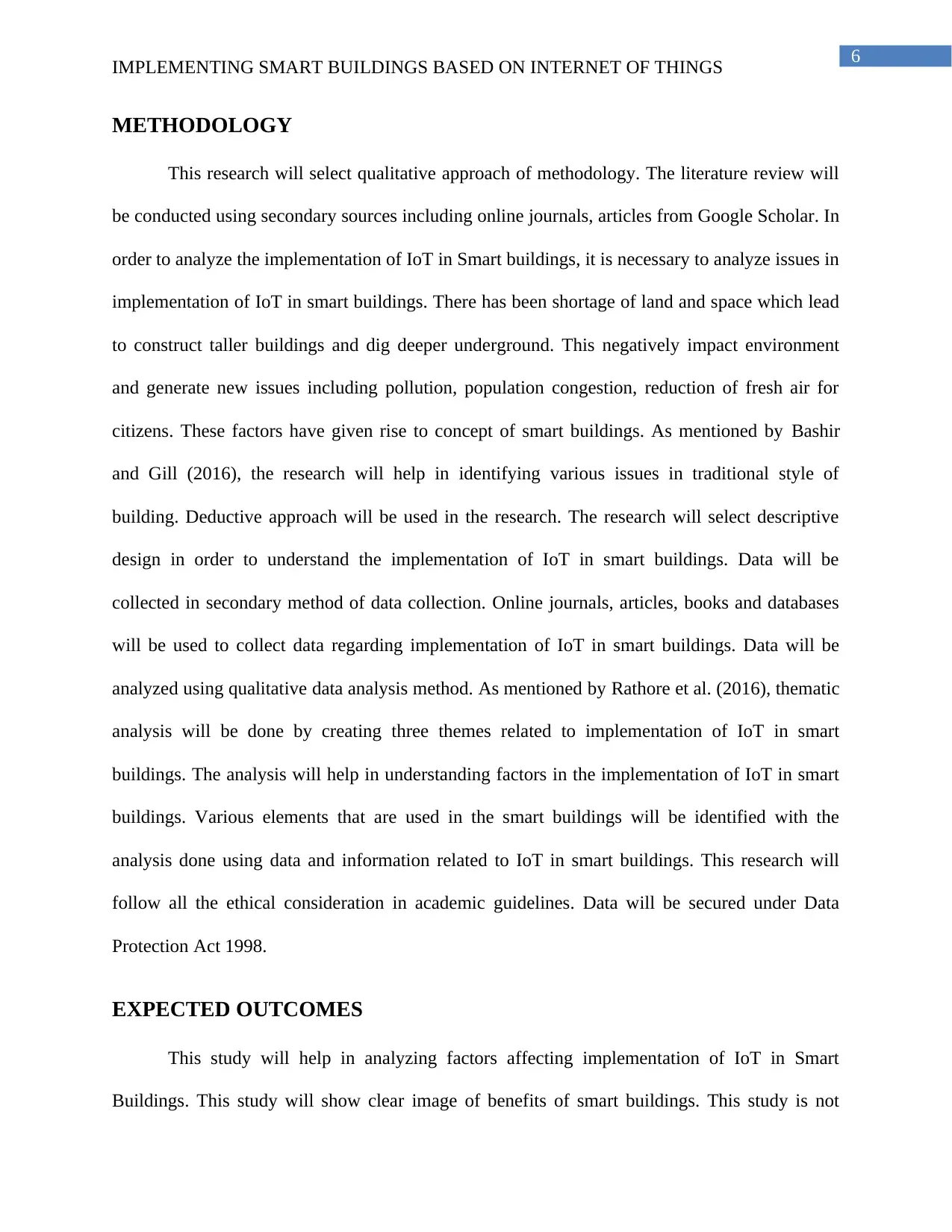
6
IMPLEMENTING SMART BUILDINGS BASED ON INTERNET OF THINGS
METHODOLOGY
This research will select qualitative approach of methodology. The literature review will
be conducted using secondary sources including online journals, articles from Google Scholar. In
order to analyze the implementation of IoT in Smart buildings, it is necessary to analyze issues in
implementation of IoT in smart buildings. There has been shortage of land and space which lead
to construct taller buildings and dig deeper underground. This negatively impact environment
and generate new issues including pollution, population congestion, reduction of fresh air for
citizens. These factors have given rise to concept of smart buildings. As mentioned by Bashir
and Gill (2016), the research will help in identifying various issues in traditional style of
building. Deductive approach will be used in the research. The research will select descriptive
design in order to understand the implementation of IoT in smart buildings. Data will be
collected in secondary method of data collection. Online journals, articles, books and databases
will be used to collect data regarding implementation of IoT in smart buildings. Data will be
analyzed using qualitative data analysis method. As mentioned by Rathore et al. (2016), thematic
analysis will be done by creating three themes related to implementation of IoT in smart
buildings. The analysis will help in understanding factors in the implementation of IoT in smart
buildings. Various elements that are used in the smart buildings will be identified with the
analysis done using data and information related to IoT in smart buildings. This research will
follow all the ethical consideration in academic guidelines. Data will be secured under Data
Protection Act 1998.
EXPECTED OUTCOMES
This study will help in analyzing factors affecting implementation of IoT in Smart
Buildings. This study will show clear image of benefits of smart buildings. This study is not
IMPLEMENTING SMART BUILDINGS BASED ON INTERNET OF THINGS
METHODOLOGY
This research will select qualitative approach of methodology. The literature review will
be conducted using secondary sources including online journals, articles from Google Scholar. In
order to analyze the implementation of IoT in Smart buildings, it is necessary to analyze issues in
implementation of IoT in smart buildings. There has been shortage of land and space which lead
to construct taller buildings and dig deeper underground. This negatively impact environment
and generate new issues including pollution, population congestion, reduction of fresh air for
citizens. These factors have given rise to concept of smart buildings. As mentioned by Bashir
and Gill (2016), the research will help in identifying various issues in traditional style of
building. Deductive approach will be used in the research. The research will select descriptive
design in order to understand the implementation of IoT in smart buildings. Data will be
collected in secondary method of data collection. Online journals, articles, books and databases
will be used to collect data regarding implementation of IoT in smart buildings. Data will be
analyzed using qualitative data analysis method. As mentioned by Rathore et al. (2016), thematic
analysis will be done by creating three themes related to implementation of IoT in smart
buildings. The analysis will help in understanding factors in the implementation of IoT in smart
buildings. Various elements that are used in the smart buildings will be identified with the
analysis done using data and information related to IoT in smart buildings. This research will
follow all the ethical consideration in academic guidelines. Data will be secured under Data
Protection Act 1998.
EXPECTED OUTCOMES
This study will help in analyzing factors affecting implementation of IoT in Smart
Buildings. This study will show clear image of benefits of smart buildings. This study is not
⊘ This is a preview!⊘
Do you want full access?
Subscribe today to unlock all pages.

Trusted by 1+ million students worldwide
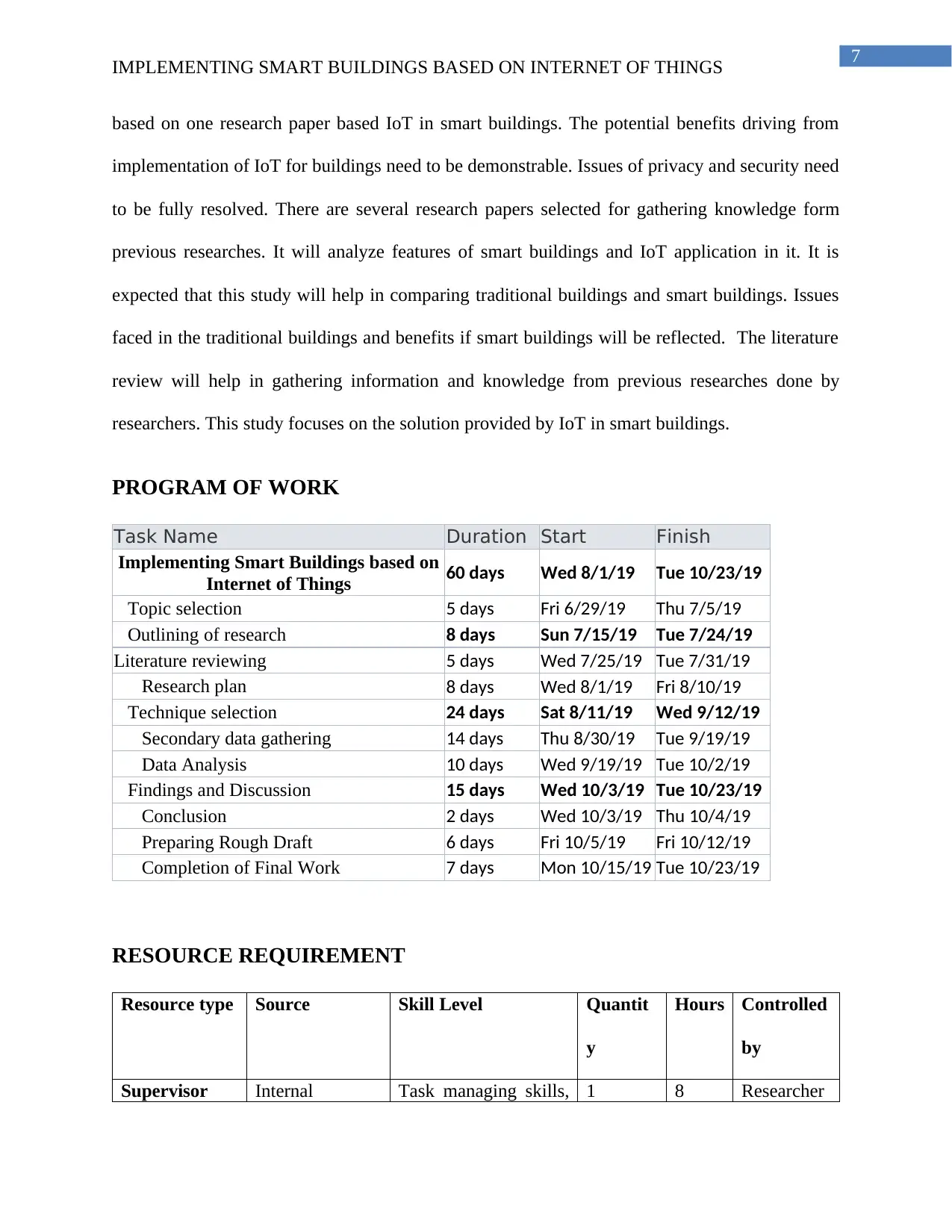
7
IMPLEMENTING SMART BUILDINGS BASED ON INTERNET OF THINGS
based on one research paper based IoT in smart buildings. The potential benefits driving from
implementation of IoT for buildings need to be demonstrable. Issues of privacy and security need
to be fully resolved. There are several research papers selected for gathering knowledge form
previous researches. It will analyze features of smart buildings and IoT application in it. It is
expected that this study will help in comparing traditional buildings and smart buildings. Issues
faced in the traditional buildings and benefits if smart buildings will be reflected. The literature
review will help in gathering information and knowledge from previous researches done by
researchers. This study focuses on the solution provided by IoT in smart buildings.
PROGRAM OF WORK
Task Name Duration Start Finish
Implementing Smart Buildings based on
Internet of Things 60 days Wed 8/1/19 Tue 10/23/19
Topic selection 5 days Fri 6/29/19 Thu 7/5/19
Outlining of research 8 days Sun 7/15/19 Tue 7/24/19
Literature reviewing 5 days Wed 7/25/19 Tue 7/31/19
Research plan 8 days Wed 8/1/19 Fri 8/10/19
Technique selection 24 days Sat 8/11/19 Wed 9/12/19
Secondary data gathering 14 days Thu 8/30/19 Tue 9/19/19
Data Analysis 10 days Wed 9/19/19 Tue 10/2/19
Findings and Discussion 15 days Wed 10/3/19 Tue 10/23/19
Conclusion 2 days Wed 10/3/19 Thu 10/4/19
Preparing Rough Draft 6 days Fri 10/5/19 Fri 10/12/19
Completion of Final Work 7 days Mon 10/15/19 Tue 10/23/19
RESOURCE REQUIREMENT
Resource type Source Skill Level Quantit
y
Hours Controlled
by
Supervisor Internal Task managing skills, 1 8 Researcher
IMPLEMENTING SMART BUILDINGS BASED ON INTERNET OF THINGS
based on one research paper based IoT in smart buildings. The potential benefits driving from
implementation of IoT for buildings need to be demonstrable. Issues of privacy and security need
to be fully resolved. There are several research papers selected for gathering knowledge form
previous researches. It will analyze features of smart buildings and IoT application in it. It is
expected that this study will help in comparing traditional buildings and smart buildings. Issues
faced in the traditional buildings and benefits if smart buildings will be reflected. The literature
review will help in gathering information and knowledge from previous researches done by
researchers. This study focuses on the solution provided by IoT in smart buildings.
PROGRAM OF WORK
Task Name Duration Start Finish
Implementing Smart Buildings based on
Internet of Things 60 days Wed 8/1/19 Tue 10/23/19
Topic selection 5 days Fri 6/29/19 Thu 7/5/19
Outlining of research 8 days Sun 7/15/19 Tue 7/24/19
Literature reviewing 5 days Wed 7/25/19 Tue 7/31/19
Research plan 8 days Wed 8/1/19 Fri 8/10/19
Technique selection 24 days Sat 8/11/19 Wed 9/12/19
Secondary data gathering 14 days Thu 8/30/19 Tue 9/19/19
Data Analysis 10 days Wed 9/19/19 Tue 10/2/19
Findings and Discussion 15 days Wed 10/3/19 Tue 10/23/19
Conclusion 2 days Wed 10/3/19 Thu 10/4/19
Preparing Rough Draft 6 days Fri 10/5/19 Fri 10/12/19
Completion of Final Work 7 days Mon 10/15/19 Tue 10/23/19
RESOURCE REQUIREMENT
Resource type Source Skill Level Quantit
y
Hours Controlled
by
Supervisor Internal Task managing skills, 1 8 Researcher
Paraphrase This Document
Need a fresh take? Get an instant paraphrase of this document with our AI Paraphraser
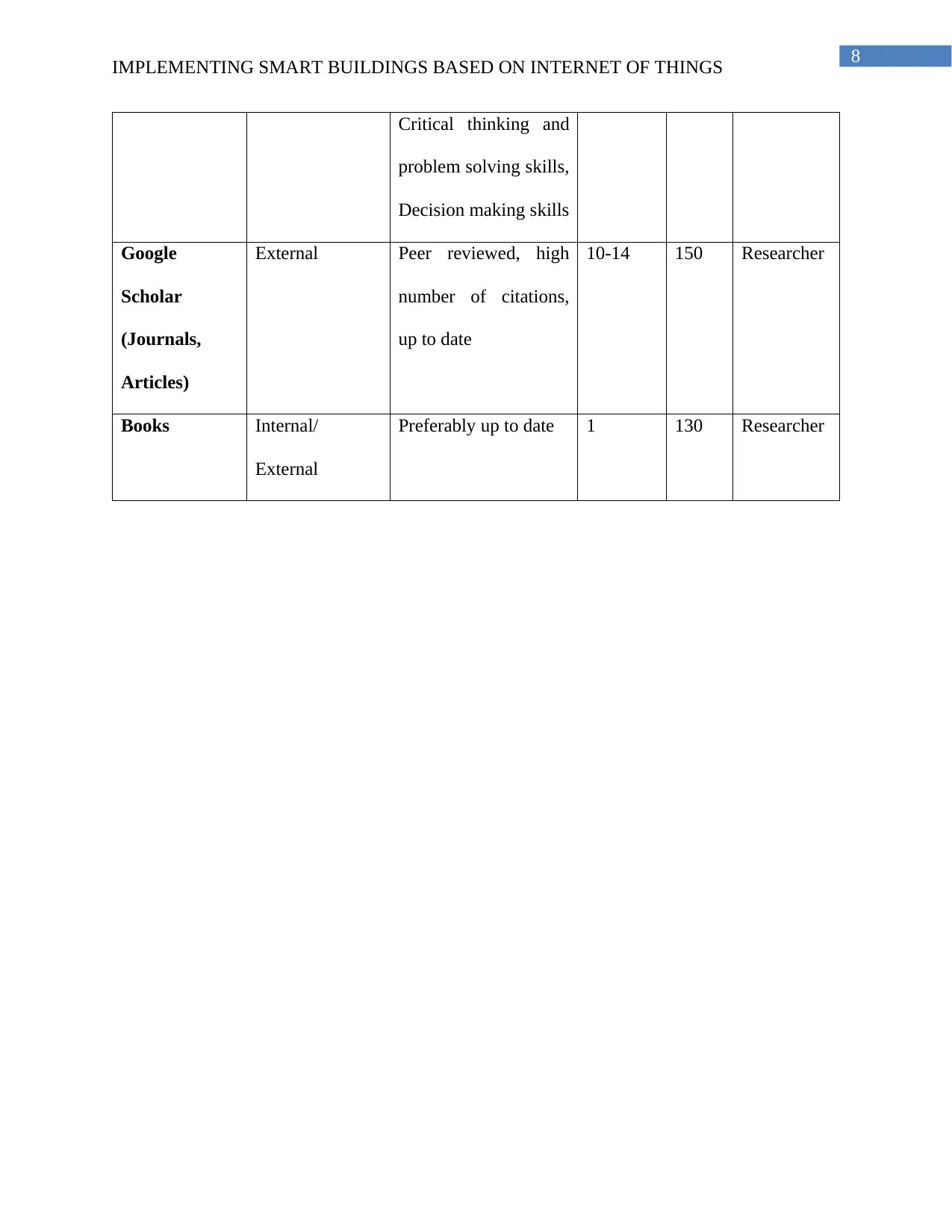
8
IMPLEMENTING SMART BUILDINGS BASED ON INTERNET OF THINGS
Critical thinking and
problem solving skills,
Decision making skills
Google
Scholar
(Journals,
Articles)
External Peer reviewed, high
number of citations,
up to date
10-14 150 Researcher
Books Internal/
External
Preferably up to date 1 130 Researcher
IMPLEMENTING SMART BUILDINGS BASED ON INTERNET OF THINGS
Critical thinking and
problem solving skills,
Decision making skills
Scholar
(Journals,
Articles)
External Peer reviewed, high
number of citations,
up to date
10-14 150 Researcher
Books Internal/
External
Preferably up to date 1 130 Researcher
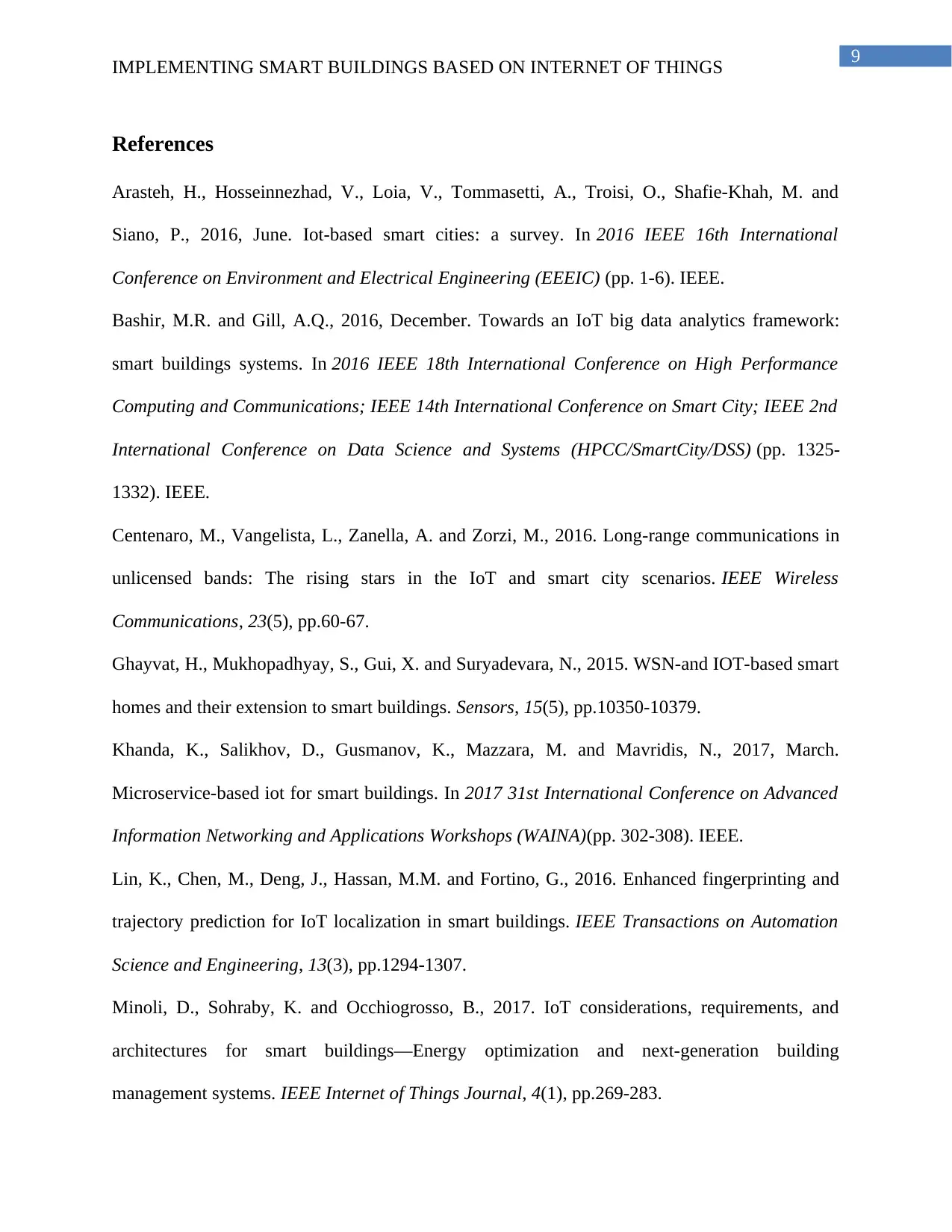
9
IMPLEMENTING SMART BUILDINGS BASED ON INTERNET OF THINGS
References
Arasteh, H., Hosseinnezhad, V., Loia, V., Tommasetti, A., Troisi, O., Shafie-Khah, M. and
Siano, P., 2016, June. Iot-based smart cities: a survey. In 2016 IEEE 16th International
Conference on Environment and Electrical Engineering (EEEIC) (pp. 1-6). IEEE.
Bashir, M.R. and Gill, A.Q., 2016, December. Towards an IoT big data analytics framework:
smart buildings systems. In 2016 IEEE 18th International Conference on High Performance
Computing and Communications; IEEE 14th International Conference on Smart City; IEEE 2nd
International Conference on Data Science and Systems (HPCC/SmartCity/DSS) (pp. 1325-
1332). IEEE.
Centenaro, M., Vangelista, L., Zanella, A. and Zorzi, M., 2016. Long-range communications in
unlicensed bands: The rising stars in the IoT and smart city scenarios. IEEE Wireless
Communications, 23(5), pp.60-67.
Ghayvat, H., Mukhopadhyay, S., Gui, X. and Suryadevara, N., 2015. WSN-and IOT-based smart
homes and their extension to smart buildings. Sensors, 15(5), pp.10350-10379.
Khanda, K., Salikhov, D., Gusmanov, K., Mazzara, M. and Mavridis, N., 2017, March.
Microservice-based iot for smart buildings. In 2017 31st International Conference on Advanced
Information Networking and Applications Workshops (WAINA)(pp. 302-308). IEEE.
Lin, K., Chen, M., Deng, J., Hassan, M.M. and Fortino, G., 2016. Enhanced fingerprinting and
trajectory prediction for IoT localization in smart buildings. IEEE Transactions on Automation
Science and Engineering, 13(3), pp.1294-1307.
Minoli, D., Sohraby, K. and Occhiogrosso, B., 2017. IoT considerations, requirements, and
architectures for smart buildings—Energy optimization and next-generation building
management systems. IEEE Internet of Things Journal, 4(1), pp.269-283.
IMPLEMENTING SMART BUILDINGS BASED ON INTERNET OF THINGS
References
Arasteh, H., Hosseinnezhad, V., Loia, V., Tommasetti, A., Troisi, O., Shafie-Khah, M. and
Siano, P., 2016, June. Iot-based smart cities: a survey. In 2016 IEEE 16th International
Conference on Environment and Electrical Engineering (EEEIC) (pp. 1-6). IEEE.
Bashir, M.R. and Gill, A.Q., 2016, December. Towards an IoT big data analytics framework:
smart buildings systems. In 2016 IEEE 18th International Conference on High Performance
Computing and Communications; IEEE 14th International Conference on Smart City; IEEE 2nd
International Conference on Data Science and Systems (HPCC/SmartCity/DSS) (pp. 1325-
1332). IEEE.
Centenaro, M., Vangelista, L., Zanella, A. and Zorzi, M., 2016. Long-range communications in
unlicensed bands: The rising stars in the IoT and smart city scenarios. IEEE Wireless
Communications, 23(5), pp.60-67.
Ghayvat, H., Mukhopadhyay, S., Gui, X. and Suryadevara, N., 2015. WSN-and IOT-based smart
homes and their extension to smart buildings. Sensors, 15(5), pp.10350-10379.
Khanda, K., Salikhov, D., Gusmanov, K., Mazzara, M. and Mavridis, N., 2017, March.
Microservice-based iot for smart buildings. In 2017 31st International Conference on Advanced
Information Networking and Applications Workshops (WAINA)(pp. 302-308). IEEE.
Lin, K., Chen, M., Deng, J., Hassan, M.M. and Fortino, G., 2016. Enhanced fingerprinting and
trajectory prediction for IoT localization in smart buildings. IEEE Transactions on Automation
Science and Engineering, 13(3), pp.1294-1307.
Minoli, D., Sohraby, K. and Occhiogrosso, B., 2017. IoT considerations, requirements, and
architectures for smart buildings—Energy optimization and next-generation building
management systems. IEEE Internet of Things Journal, 4(1), pp.269-283.
⊘ This is a preview!⊘
Do you want full access?
Subscribe today to unlock all pages.

Trusted by 1+ million students worldwide
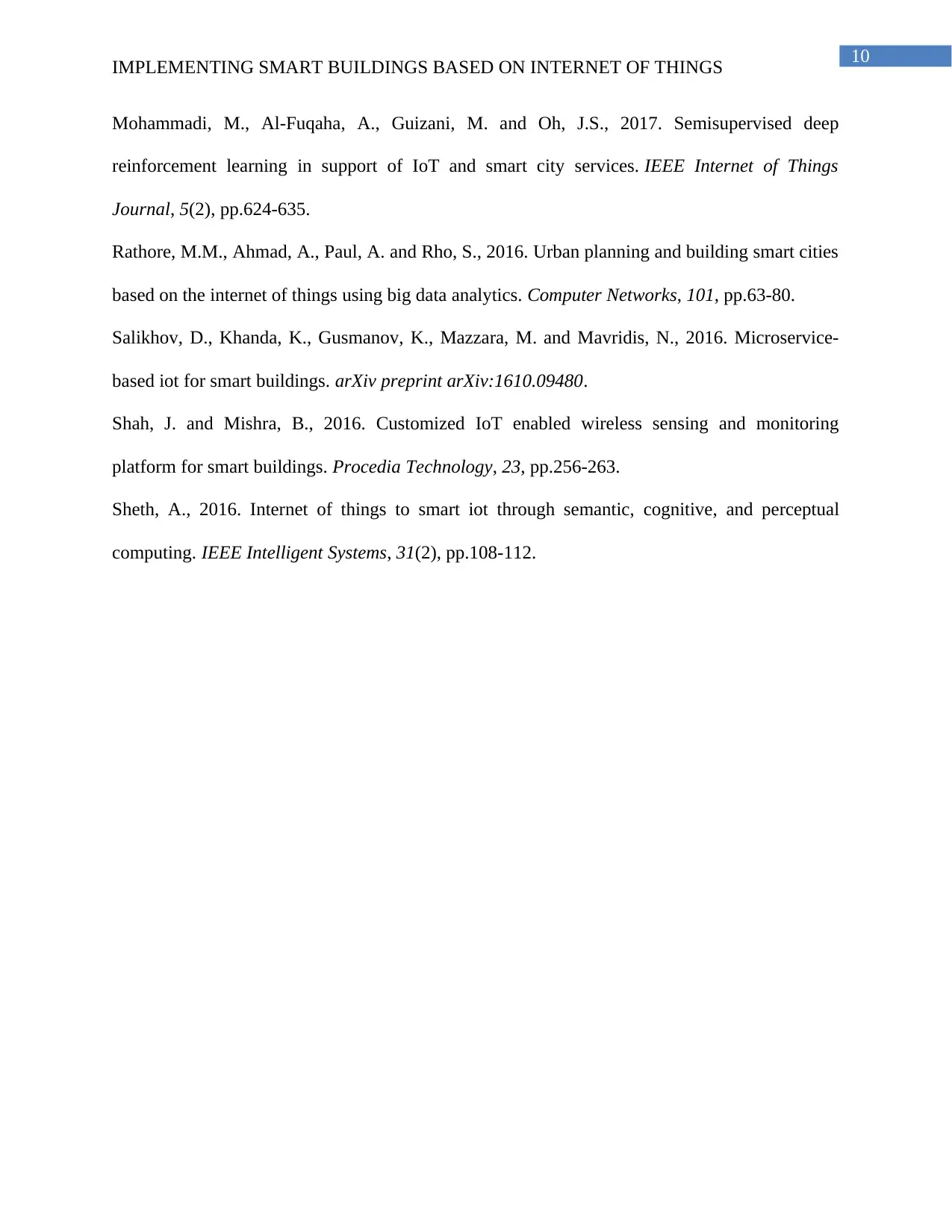
10
IMPLEMENTING SMART BUILDINGS BASED ON INTERNET OF THINGS
Mohammadi, M., Al-Fuqaha, A., Guizani, M. and Oh, J.S., 2017. Semisupervised deep
reinforcement learning in support of IoT and smart city services. IEEE Internet of Things
Journal, 5(2), pp.624-635.
Rathore, M.M., Ahmad, A., Paul, A. and Rho, S., 2016. Urban planning and building smart cities
based on the internet of things using big data analytics. Computer Networks, 101, pp.63-80.
Salikhov, D., Khanda, K., Gusmanov, K., Mazzara, M. and Mavridis, N., 2016. Microservice-
based iot for smart buildings. arXiv preprint arXiv:1610.09480.
Shah, J. and Mishra, B., 2016. Customized IoT enabled wireless sensing and monitoring
platform for smart buildings. Procedia Technology, 23, pp.256-263.
Sheth, A., 2016. Internet of things to smart iot through semantic, cognitive, and perceptual
computing. IEEE Intelligent Systems, 31(2), pp.108-112.
IMPLEMENTING SMART BUILDINGS BASED ON INTERNET OF THINGS
Mohammadi, M., Al-Fuqaha, A., Guizani, M. and Oh, J.S., 2017. Semisupervised deep
reinforcement learning in support of IoT and smart city services. IEEE Internet of Things
Journal, 5(2), pp.624-635.
Rathore, M.M., Ahmad, A., Paul, A. and Rho, S., 2016. Urban planning and building smart cities
based on the internet of things using big data analytics. Computer Networks, 101, pp.63-80.
Salikhov, D., Khanda, K., Gusmanov, K., Mazzara, M. and Mavridis, N., 2016. Microservice-
based iot for smart buildings. arXiv preprint arXiv:1610.09480.
Shah, J. and Mishra, B., 2016. Customized IoT enabled wireless sensing and monitoring
platform for smart buildings. Procedia Technology, 23, pp.256-263.
Sheth, A., 2016. Internet of things to smart iot through semantic, cognitive, and perceptual
computing. IEEE Intelligent Systems, 31(2), pp.108-112.
1 out of 10
Related Documents
Your All-in-One AI-Powered Toolkit for Academic Success.
+13062052269
info@desklib.com
Available 24*7 on WhatsApp / Email
![[object Object]](/_next/static/media/star-bottom.7253800d.svg)
Unlock your academic potential
Copyright © 2020–2025 A2Z Services. All Rights Reserved. Developed and managed by ZUCOL.





